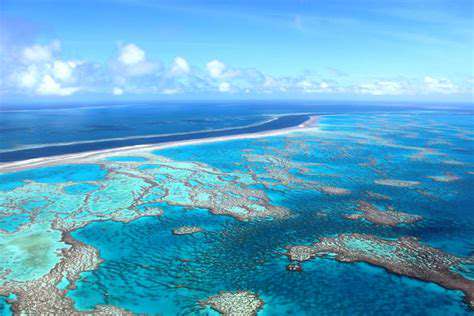Top Destinations for Scuba Diving in 2025

A Living Mosaic of Marine Life
Stretching like an underwater continent along Australia's northeast coast, the Great Barrier Reef isn't just large - it's a living, breathing world unto itself. Imagine 900 individual reefs and 3,000 coral cays creating a marine metropolis that would stretch from New York to Miami if placed on land. This isn't merely a collection of corals; it's the most complex natural system on Earth after tropical rainforests.
What truly astonishes scientists is how this ecosystem functions as a single organism. Tiny polyps no larger than a pencil eraser build limestone skeletons that become the foundation for entire food chains. From microscopic plankton to 40-ton humpback whales, every creature plays a role in this underwater ballet.
How Coral Cities Are Built
The reef's construction crew consists of coral polyps - tiny, soft-bodied creatures related to jellyfish. These remarkable architects secrete calcium carbonate at a rate of about 1-3 cm per year under ideal conditions. What we see as colorful coral structures are actually the accumulated apartments of generations of polyps.
These living skyscrapers don't just house their builders. The nooks and crannies between coral branches become nurseries for fish, hiding spots for octopuses, and hunting grounds for reef sharks. The entire structure functions like an underwater Manhattan, with different neighborhoods hosting distinct communities.
Challenges Facing the Reef
Climate change acts like a slow-moving hurricane for coral ecosystems. Rising temperatures cause corals to expel their colorful algae partners (zooxanthellae) in events called bleaching. Without these algae, corals starve - turning ghostly white before dying. Ocean acidification makes it harder for new polyps to build their skeletons, like trying to construct a house while the cement won't set.
Agricultural runoff creates another invisible threat. Fertilizers washing into the sea feed algal blooms that smother corals. Meanwhile, crown-of-thorns starfish outbreaks - possibly fueled by nutrient pollution - can devour football-field-sized patches of reef in weeks.
Why Coral Reefs Matter
Coral reefs represent the ocean's equivalent of tropical rainforests, hosting about 25% of marine species while covering less than 1% of the seafloor. Their economic value is staggering - the Great Barrier Reef alone contributes about $6.4 billion annually to Australia's economy through tourism and fisheries.
These living breakwaters protect coastlines better than any human-made structure. Healthy reefs reduce wave energy by an average of 97%, preventing erosion and saving coastal communities billions in potential storm damage. Their pharmaceutical potential is equally impressive, with coral compounds showing promise in treatments for cancer, arthritis, and bacterial infections.
Saving the Reef
Innovative conservation strategies are being deployed across the reef. Coral nurseries grow resilient strains for transplantation, while underwater robots target crown-of-thorns starfish. New farming techniques reduce fertilizer runoff, and improved wastewater treatment keeps nutrients from reaching the reef.
Perhaps most importantly, traditional owner groups are playing a central role in management. Indigenous rangers combine millennia of ecological knowledge with modern science to monitor reef health and implement protection measures.
The Science of Survival
Researchers employ cutting-edge technology to understand reef dynamics. Autonomous underwater vehicles map reef structures in 3D, while DNA analysis tracks how species adapt to changing conditions. Satellite monitoring provides real-time data on water temperature and quality across the entire reef system.
Citizen science programs engage divers in vital data collection. From photographing reef fish to recording coral bleaching, these volunteer efforts dramatically expand scientists' monitoring capacity. The data reveals both troubling declines and hopeful signs of resilience in different reef areas.
Maldives: Where Luxury Meets the Deep
Diving Into Perfection
The Maldives transforms diving from a sport into an art form. Picture descending into water so clear it feels like flying, where manta rays perform balletic loops and whale sharks glide past like silent submarines. The archipelago's unique geography - 26 atolls comprising over 1,000 islands - creates countless channels where nutrient-rich currents attract marine megafauna.
What makes Maldivian diving truly special are the thilas - submerged coral mountains that rise dramatically from the deep. These underwater oases attract everything from colorful reef fish to schools of hunting tuna. Night diving reveals another world entirely, as bioluminescent organisms light up the water and nocturnal hunters emerge.
Island Sanctuaries
Maldivian resorts redefine luxury through harmony with nature. Overwater bungalows aren't just accommodations - they're private observatories where you can watch reef sharks patrol the shallows from your glass floor. The true genius lies in how these resorts make sustainability feel indulgent. Solar-powered villas, desalination plants, and coral regeneration projects demonstrate that luxury needn't come at the environment's expense.
Service reaches new heights here. Personal butlers anticipate needs before you voice them, while chefs craft meals from the day's freshest catch. Spa treatments incorporate local ingredients like coconut and sea salt, blending ancient traditions with modern wellness science.
A Living Aquarium
The Maldives' marine biodiversity would make Darwin dizzy. The islands sit at a biological crossroads where Indian Ocean species mingle with Pacific migrants. Coral reefs display psychedelic color schemes, home to over 2,000 fish species. Cleaning stations attract everything from tiny wrasses to massive manta rays, offering front-row seats to nature's symbiotic relationships.
Seasonal phenomena elevate the spectacle. From August to November, plankton blooms attract hundreds of mantas to feeding frenzies. Between June and December, whale sharks congregate in the southern atolls. The Maldives' protected marine areas ensure these encounters remain sustainable for generations.
Diving for Every Passion
Beginners find ideal conditions in shallow lagoons where gentle currents carry them over coral gardens. Advanced divers test their skills in channel drifts, riding currents through canyons of coral. Wreck enthusiasts explore sunken ships now crusted with corals and home to schools of fish.
Technical diving opens even more possibilities. Deeper sites reveal untouched coral walls and the chance to spot rare species like the Maldivian sponge snail. Underwater photographers find endless subjects, from macro critters in the reef's nooks to wide-angle shots of schooling fish.
Beyond the Beach
While resorts offer paradise perfected, local islands reveal the Maldives' authentic culture. In places like Maafushi, visitors can learn traditional crafts like lacquer work or join fishermen using pole-and-line techniques unchanged for centuries. The capital Malé packs surprises too, from vibrant fish markets to the gold-domed Islamic Centre.
Cultural experiences add depth to any visit. Local bodu beru drumming performances echo ancestral rhythms, while Maldivian cuisine - a fusion of Sri Lankan, Indian and Arab influences - offers flavors as vibrant as the surrounding reefs.
The Red Sea: Where Desert Meets Deep
Reefs Like No Other
The Red Sea's reefs stand apart for their resilience and beauty. While coral suffers globally, these reefs show remarkable resistance to warming waters. Scientists believe local adaptations and the sea's unique geology create this hardiness. The result? Vibrant coral gardens where every hue seems intensified by the clear water.
Diving here feels like swimming through a living kaleidoscope. Table corals stretch like banquet tables for reef fish, while delicate soft corals wave in the current. The coral diversity is staggering - over 300 species create architectural wonders that would make Gaudi jealous.
Crystal Waters, Stark Contrasts
The Red Sea offers visibility that can exceed 40 meters - so clear it tricks your depth perception. This clarity comes from the desert environment; with no rivers bringing silt or pollution, the water remains pristine. The contrast between the barren desert above and the teeming life below creates a surreal experience.
Underwater topography rivals any mountain landscape. Sheer walls plunge into the deep, while coral pinnacles rise like skyscrapers. Canyons and swim-throughs create natural adventure parks for divers. The play of sunlight through these structures creates ever-changing light shows.
A Biological Crossroads
The Red Sea's unique position - nearly enclosed yet connected to the Indian Ocean - has created species found nowhere else. About 10% of its fish are endemic, including the charming Red Sea clownfish. The reefs buzz with activity: moray eels peer from crevices, lionfish display their venomous finery, and turtles glide past with ancient grace.
Pelagic encounters add excitement. Schools of barracuda form living silver tornadoes, while the occasional hammerhead shark cruises the deeper reefs. At certain times of year, massive whale shark gatherings occur near places like Djibouti's Ghoubbet al-Kharab.
Time Capsules Below
The Red Sea's shipwrecks read like a history book. The SS Thistlegorm, sunk in 1941, remains packed with WWII-era trucks, motorcycles, and even locomotives. More recent wrecks like the Salem Express tell poignant human stories. These artificial reefs now host more marine life than many natural sites.
Wreck diving here offers unparalleled access. Many ships rest in relatively shallow water, their superstructures often reaching close to the surface. Penetration dives reveal intact cabins and cargo holds where time seems frozen. The play of light through rusting hulls creates hauntingly beautiful scenes.
Diving Infrastructure Done Right
Egypt's Red Sea coast has perfected the dive vacation. Liveaboards range from budget-friendly to floating palaces, accessing remote reefs unreachable from shore. Shore-based operations offer everything from quick boat dives to multi-day safari trips along the coast.
What sets the region apart is its dive professionals. Many instructors have logged thousands of dives in local waters, knowing each reef's secrets. Safety standards rival any global destination, while prices remain surprisingly affordable compared to other world-class dive locations.
Year-Round Diving Perfection
The Red Sea offers two distinct diving seasons. Summer (May-September) brings warmer waters (up to 30°C) and calm conditions ideal for northern sites. Winter (October-April) sees slightly cooler waters (21-24°C) but exceptional visibility and the chance to spot pelagics in southern areas.
Microclimates create variety. The Gulf of Aqaba stays relatively calm year-round, while the southern Red Sea near Sudan offers more adventurous conditions. This diversity means there's always somewhere perfect to dive, regardless of season.
Value Beyond Compare
Nowhere else offers such world-class diving at these prices. Budget travelers find clean, comfortable accommodations near prime dive sites. Mid-range options provide excellent value with pools, spas, and quality restaurants. Even luxury resorts cost far less than comparable properties in the Caribbean or South Pacific.
The affordability extends underwater. Dive packages often include equipment, while tank fills cost a fraction of Western prices. This accessibility makes the Red Sea ideal for everyone from students doing their first open water dives to professionals logging their hundredth.
Galapagos: Evolution's Playground

Nature's Laboratory
The Galapagos Islands aren't just a destination - they're a living lesson in biology. Here, marine iguanas sun themselves after diving for algae, while blue-footed boobies perform comical mating dances. What makes these islands extraordinary is how fearlessly wildlife approaches humans. This lack of predation has created animals that see us as curiosities rather than threats.
Charles Darwin only scratched the surface of the islands' evolutionary marvels. Modern scientists continue discovering new adaptations, like the vampire finch that drinks seabird blood during dry seasons. The ongoing volcanic activity means new species may be evolving before our eyes.
Landscapes From Another Planet
The Galapagos' volcanic origins create scenery that feels extraterrestrial. On Bartolomé Island, the iconic Pinnacle Rock rises from a landscape of volcanic cones and lava flows. Sierra Negra volcano boasts one of the world's largest calderas - a 6-mile-wide depression that last erupted in 2018.
These geological features aren't just scenic - they create microhabitats. Highland areas receive moisture from garúa (mist), creating lush Scalesia forests. Coastal zones blend black lava rocks with white sand beaches where sea turtles nest. Each island develops distinct ecosystems based on its age and geology.
Marine Wonders
The Galapagos Marine Reserve protects one of the planet's richest underwater ecosystems. Cold currents from the west and warm currents from the east collide here, creating a nutrient soup that supports incredible biodiversity. Nowhere else can you snorkel with penguins one day and tropical fish the next.
Underwater encounters redefine wildlife viewing. Sea lions perform aquatic acrobatics around divers, while schools of hammerhead sharks patrol deeper sites. Marine turtles so large they resemble small cars glide past, undisturbed by human observers. The reserve's protection ensures these encounters remain sustainable.
Conservation in Action
Galapagos conservation represents a global model. Strict visitor quotas prevent overcrowding, while all tours must follow certified naturalist guides. The islands pioneered sustainable practices like biosecurity measures to prevent invasive species introduction.
Success stories abound. Giant tortoise populations have rebounded from near extinction. Flightless cormorants and mangrove finches benefit from targeted protection programs. Even the islands' famous lonesome George serves as a conservation icon, despite being the last of his subspecies.
Human Stories
The Galapagos' human history is as fascinating as its natural one. From early whalers to eccentric settlers like the Wittmer family, the islands have attracted remarkable characters. Today, about 30,000 residents balance modern life with environmental stewardship.
Local communities contribute significantly to conservation. Fishermen now participate in sustainable lobster fisheries, while farmers adopt organic techniques. The islands' research stations employ many locals, creating economic incentives for preservation.
Travel That Matters
Visiting the Galapagos responsibly requires careful planning. Smaller ships (under 100 passengers) minimize environmental impact while allowing access to more visitor sites. Land-based options on select islands offer alternatives to cruising.
Every visitor directly funds conservation through park fees and tourism taxes. Many operators contribute additional support through citizen science programs or direct donations to research. The result is a tourism model that protects what it promotes - ensuring the Galapagos remain extraordinary for generations.






![Top 10 Adventure Destinations in the World [2025]](/static/images/27/2025-05/ConqueringtheHimalayas3AMountaineeringandTrekkinginNepal.jpg)




